Excerpts from Jim Conrad's
Naturalist Newsletter
Entry dated April 21, 2024, from notes taken about 1km northwest of Puerto de los Velazquez, Municipality of Pinal de Amoles; N21.124°, W99.679°, elevation ~2750 meters (~9020 feet); oak-pine on limestone bedrock; in the Eastern Sierra Madre Mountains of east-central Querétaro state, MÉXICO
FUCHSIA ENCLIANDRA
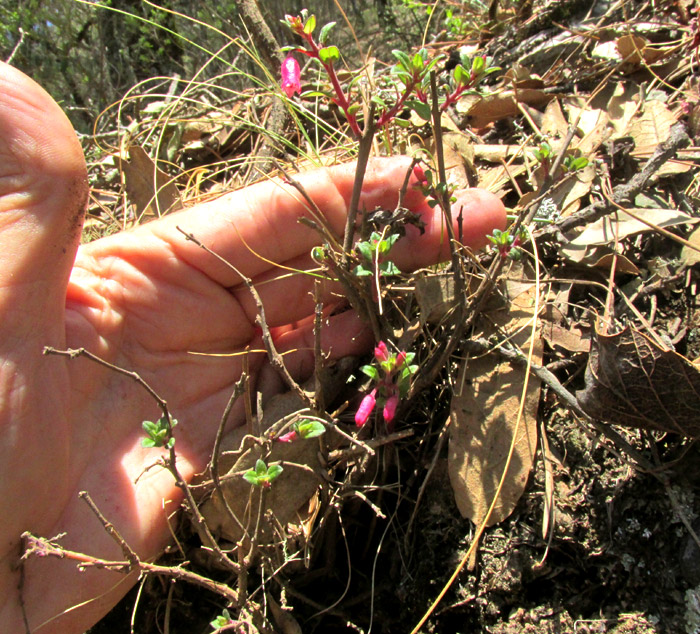
On a steep, south-facing slope atop a low roadcut through limestone, the above woody shrub looked as if it had been cropped by grazing animals, lost its leaves, and now was issuing new leaf-bearing stems with pink flowers. The plant's appearance might reflect the ongoing weather pattern the North American Drought Monitor maps as a D4 Drought, the droughtiest category they have, the one beyond D2 Severe and D3 Extreme.

At the right, a single pink flower bends downward at the tip of a curved pedicel originating in the axil of one of a pair of simple leaves arising opposite one another. Leaf margins show no teeth or lobes. Stem, petioles and pedicels are all pink. The usual green calyx below a colorful corolla are not apparent here.
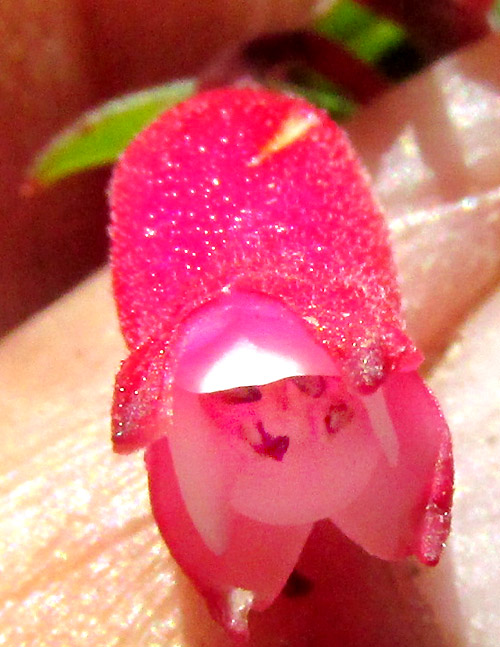
A closer view of the flower from the front shows four stamens inside a corolla consisting of four white petals. Enveloping the corolla are four triangular, red sepals atop a red area which must be the floral tube or hypanthium. At this point, our bush with its curious flowers seems to belong to one of two families: the Heath/Azalea Family, the Ericaceae, or the Evening Primrose Family, the Onagraceae. However, Heath Family species normally produce ten stamens, and the Evening Primrose Family has eight stamens attached at different levels in a 4+4 manner. Maybe our flower's four stamens have four more below them, not visible in the picture.
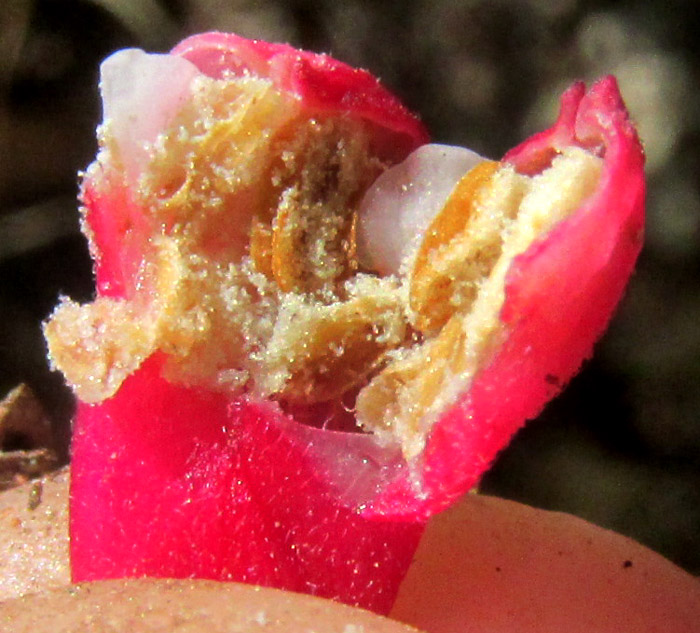
The above mess is a flower bud broken open with old-man eyes and arthritic fingers. Still, you can see two white petals, and some honey-colored things, which are anthers. Certain anthers have been shattered or burst, releasing white pollen grains. There's no evidence of female parts.
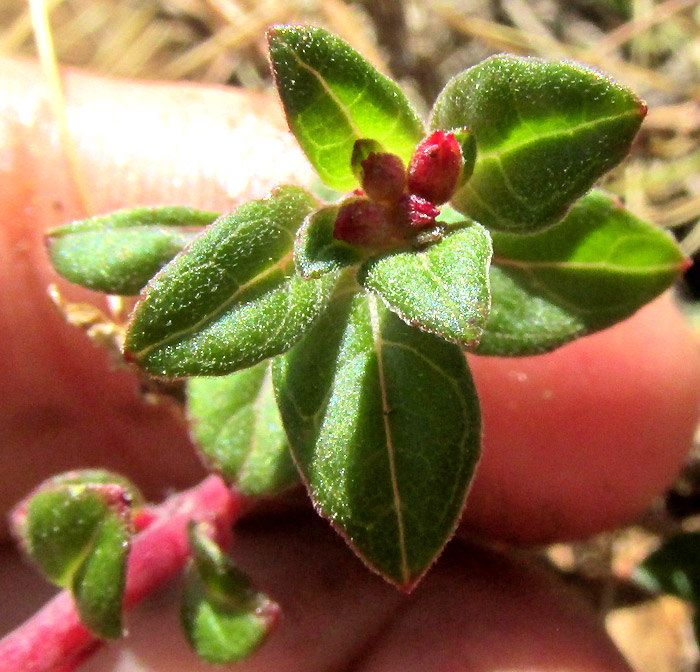
Emerging leaves bear short hairs, and veins are sunken into the blades forming wrinkles. Red flower buds cluster at the stem tip.
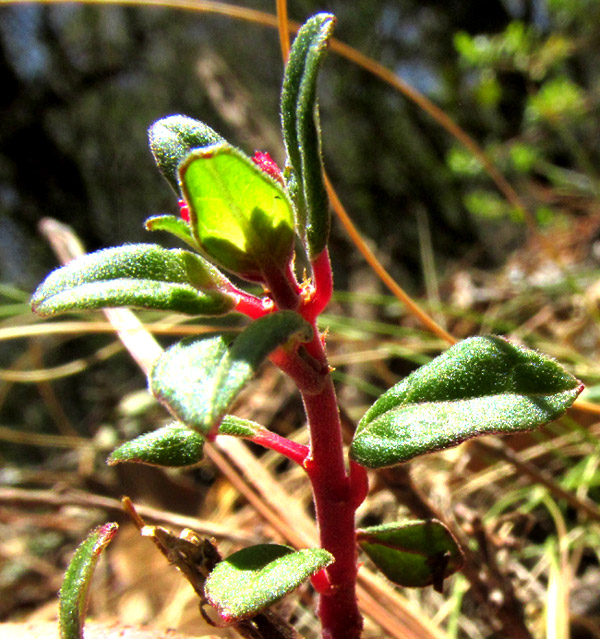
With paired leaves on a shrub with small 4-parted flowers, the Madder/Coffee Family, the Rubiaceae, might be an option. However, here we see no conspicuous, scale-like stipules at stem nodes connecting petiole bases, so our plant doesn't belong to that family.
Not only because of the suspected eight stamens and the stems' redness, the flowers are vaguely suggesting of those of ornamental fuchsias, which have eight stamens and often produce red stems. Therefore, first I looked into the fuchsias' Evening Primrose Family, the Onagraceae.
In our part of upland, central Mexico known as the Bajío, if you have a member of that family whose flowers are radially symmetrical, the bottom part of the flower has a calyx tube (the hypanthium), and the plants are woody with pairs of leaves at each stem node, you have a Fuchsia. That's true despite our shrub not looking much like the gorgeous hybrid fuchsias much sold in gardening centers. However, in various ways it does resemble the Thyme-leaved Fuchsia seen earlier in nearby Hildago state.
The Flora del Bajío documents seven Fuchsia species occurring in our Bajío region. Among those seven, if flowers appear singly in leaf axils, the flowers sometimes appear as unisexually male (as seen in our open flower bud), the calyx wall or hypanthium is red, and the leaves grow no longer than 2.7cm (1.1inch), you have FUCHSIA ENCLIANDRA, with no English name other than "fuchsia."
Fuchsia encliandra occurs fairly commonly on slopes forested with pine, oak, juniper and madrones, from central Mexico south into Nicaragua. Probably because of its small flowers, it's not much sold as a garden ornamental, though collectors sometimes plant it, naming it the Miniature-flowered Fuchsia.
The 2008 Master's thesis by Lislie Solis Montero entitled "Biología Reproductiva de Fuchsia encliandra (Onagraceae): una Población subdioica," described the sexual state of Fuchsia encliandra as morphologically subdioecious but functionally dioecious. In other words, individual Fuchsia encliandra plants may have flowers which look fully male (like our plant's examined flower) or entirely female, or something in between. This state of affairs is seen as an evolutionary transition stage from ancestral species with individual plants bearing flowers with both male and female parts, to the more recently evolved dioecious state, where individual plants produce flowers which are either male or female, but not both, and not sexually ambiguous flowers.
I find no traditional uses for Fuchsia encliandra, other than sometimes as an ornamental around country people's houses.